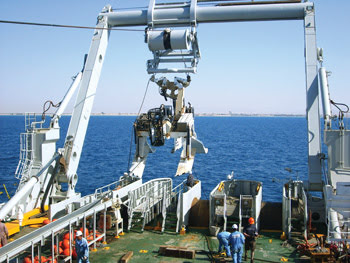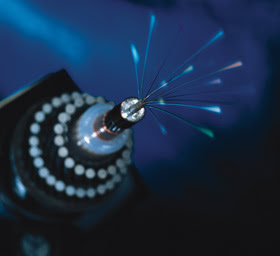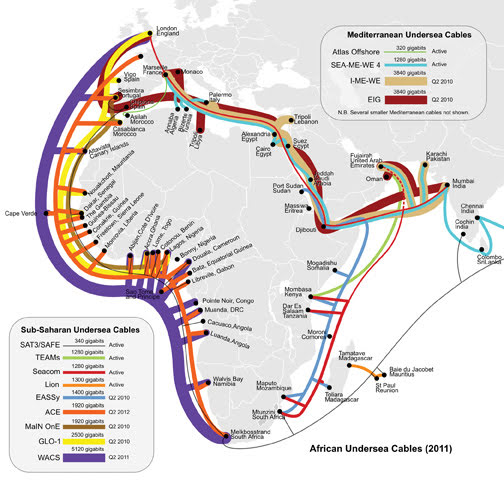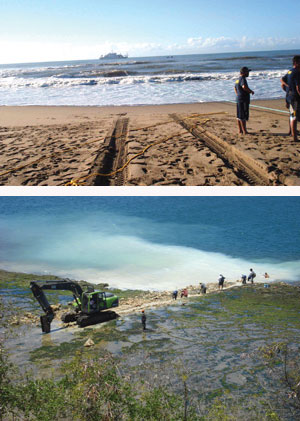Submarine cable systems bring increased connectivity to the continent
Tuesday night, April 6, 2010: The Ile de
Batz slowed to a stop in the waters of Dar es Salaam Bay, just off the Msasani Peninsula
in the east African nation of Tanzania. The ship had been traveling south from Kenya,
laying cable for the Eastern Africa Submarine Cable System (EASSy), a 10,000-km
undersea network that will connect with nine African countries along the east coast
of the continent and serve an additional 12 landlocked nations through backhaul
networks.
The cable reached shore the following morning at about 11 a.m.
From there it would travel inland, connecting Tanzania and other African nations
to networks throughout the world. Chris Wood, CEO of the West Indian Ocean Cable
Company, the largest shareholder in the project, was on hand to observe the event.

In shallow waters, cable is buried using
remotely operated sea plows. Here, a sea plow is loaded into the sea. In the background
is Ras Sidr, Egypt. Courtesy of Tyco Telecommunications.
“Interconnection with other undersea international cable
systems will enable traffic on EASSy to seamlessly connect to Europe, North and
South America, the Middle East and Asia,” he said, according to an article
in the Tanzania Daily News, “thereby enhancing the east coast of Africa’s
connectivity to the global telecommunications network.”
Just shy of two weeks later, on Monday, April 19, the EASSy cable
system was completed; testing was set to begin almost immediately, Wood said in
a statement. Soon, the fibers snaking across the floor of the Indian Ocean would
go online, bringing businesses and individuals throughout Africa ever closer to
the rest of the world.
Dramatic changes on the continent
The EASSy system, with a 1.4-Tb/s capacity, is only one of several
such initiatives. The 4500-km TEAMS (The East African Marine Systems) offers a capacity
of 120 Gb/s to 1.4 Tb/s, while the 13,700-km cable system by the SEACOM company
provides a capacity of 1.28 Tb/s.
These submarine cable systems could lead to important changes
on the continent. “East Africa was the last region in the world not to have
a fiber connection to the rest of the world,” SEACOM CEO Brian Herlihy said
recently in an e-mail. “African retail carriers can now enjoy equal and open
access to inexpensive bandwidth, removing the international infrastructure bottleneck
and supporting economic growth.”
This is important, as demand for bandwidth has increased considerably
in recent years. Africa is one of the fastest growing markets for information and
communications technology services. In many countries, especially outside South
Africa, this growth is spurred by demand for IP phones, which offer a less expensive,
more efficient means of making calls. South Africa more closely resembles Europe
and the US in its communications needs, seeking instant messaging, video calls and
other features that will aid in accelerating business.

A number of submarine fiber optic cable systems are helping to bring
increased bandwidth and improved connectivity to Africa. Shown here is a cross section
of steel-armored cable from Tyco Telecommunications. This specific type of cable
is installed on the ocean floor, usually in shallow waters. Courtesy of SEACOM.
Telephony is only one part of the picture, though. The introduction
of broadband Internet to the continent will contribute to development in a variety
of ways. “Africa can now launch itself as a major competitor for call centers/business
process outsourcing,” Herlihy said. The financial and manufacturing sectors,
among others, can lower costs even while increasing productivity. Hospitals performing
clinical studies can share data in real time with collaborating sites around the
world. And science, education and other research can be conducted in east or southern
Africa “as easily as it could be conducted in Cambridge, Massachusetts.”
The list of potential applications goes on. Using the Internet,
farmers in Tanzania will be able to access both the local and international markets
for their products without having to rely on middlemen and cooperatives. Schools
in South Africa can take advantage of resources available through the Tertiary Education
and Research Network of South Africa. And surgeons at the Regency Medical Centre
in Dar es Salaam, also in Tanzania, may be able to perform complicated procedures
in real time using telemedicine, working with major medical centers in India. Currently,
many patients find that they have to travel abroad to receive necessary treatment.
Many of these would not be possible without the vastly increased capacity provided
by the submarine cable systems.
Less critical, perhaps, but just as significant: The increased
capacity will help to facilitate faultless content delivery from the World Cup,
to be held in South Africa this month.

Undersea cable networks have recently brought vastly increased bandwidth to the east coast
of Africa, one of the last regions in the world not to have such a connection. These
join several other networks linking North Africa and the west coast of the continent
to the rest of the world. Courtesy of Steve Song / http://manypossibilities.net/african-undersea-cables.
Notably, not everyone in Africa is demanding increased capacity
and improved connectivity. At the annual Digital Sense Africa Forum held in Lagos,
Nigeria, April 17 and 18, 2010, participants noted that the nation has only 1 percent
broadband penetration out of an estimated 7 percent Internet access, in part due
to an increase in cyber crimes. “We are not Internet hungry,” said 2010
forum chairman Samuel Adeleke, according to IT News Africa. Adeleke is also president
of the Internet Service Providers Association. “There is need for active participation
both as a nation and as individuals to change the perception from the negative use
of the Internet to the positive.”
In it for the long haul
In addition to supporting education and medicine, for example,
the laying of the submarine cable systems has encouraged significant investment
in backhaul, an industry term for the portion of a telecommunications network linking
the core network to smaller subnetworks at the outer reaches. Businesses throughout
eastern and southern Africa are currently rolling out national backhaul infrastructure,
including several national operators in South Africa. In Rwanda, the national government
has laid extensive fiber networks connecting both urban and rural areas to the rest
of the world.
“All of these investments are now economically feasible
due to the substantially lower bandwidth prices brought by cables like SEACOM,”
Herlihy said, adding that retail carriers also benefit from the equal and open access
to inexpensive bandwidth. He noted, for example, that in South Africa the monthly
lease cost for an STM-1 circuit has declined by more than 50 percent since 2006,
from 2.1 million rand that year to only 0.8 million rand today. In Mozambique, many
Internet service providers are now able to offer end users the choice of either
double the bandwidth for the same price as before, or the same bandwidth for half
the price.

The submarine cable systems reach shore at points along the coast of Africa, bringing
service through backhaul networks to countries such as South Africa and Kenya as well as
to landlocked nations in the interior. Courtesy of SEACOM.
Until recently, satellite was the only means to extend information
and communications technology services to the vast majority of the continent, and
it is still likely the better option for reaching countries that have scattered
populations (Sudan and Algeria, for example) or that have recently been at war,
whose infrastructures have largely been destroyed (Congo, Sierra Leone, Liberia,
Sudan).
With the landing of the submarine cable systems, the continent
will see more and faster connections. But fiber is not likely to replace satellite
entirely. Rather, the two will prove complementary in bringing advanced information
and communications technology to Africans across the continent, thus connecting
them to the rest of the world in ways unimaginable even just a few years ago.